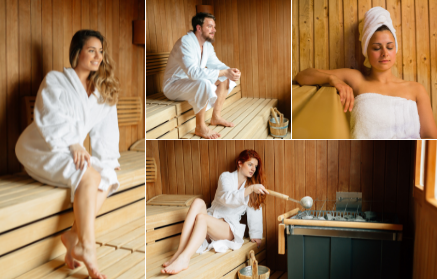Table of Contents
Do you often look for ways to warm up, especially during winter? Maybe you fly to sunny exotic destinations or you like to visit the sauna. Although there is just a small cooling pool instead of a warm sea, it has a number of other benefits. Sauna lovers can certainly confirm that the alternation between heat and cold not only helps them to relax, but also to support immunity or sports performance. Why is the sauna healthy, what are its effects and rules? You will learn all about sauna in today’s article.
What exactly is a sauna, and what is it about?
In this article we will focus primarily on the Finnish sauna. Its effects on human health are the most researched and at the same time it is used by people all over the world. Other types of saunas that you may come across include steam, tropical, bio or infrared saunas. They may offer similar benefits, but they have their own specifics, which we will talk about more some other time.
You can think of the Finnish sauna as a room with wood panelling and benches, which is heated to a temperature (60-120 °C). This is achieved thanks to wood or electric stoves. The stove is then covered with hot stones and water is poured over them to increase the humidity and air temperature in the room. During the stay in a sauna, high sweating occurs due to the heat. You go to the sauna without a swimsuit or clothes. Typically, you can take a sheet that is used mainly for hygienic reasons to absorb sweat.
A few-minute stay in a hot sauna (5-15 minutes) then alternates with the cooling phase in an ice shower, pool, or pond. Then follows a moment of rest, followed by another cycle, which again begins with a sauna. This ritual has a number of beneficial effects, and it also evokes a feeling of relaxation. So after the sauna you can feel relaxed both physically and mentally. [1–2]
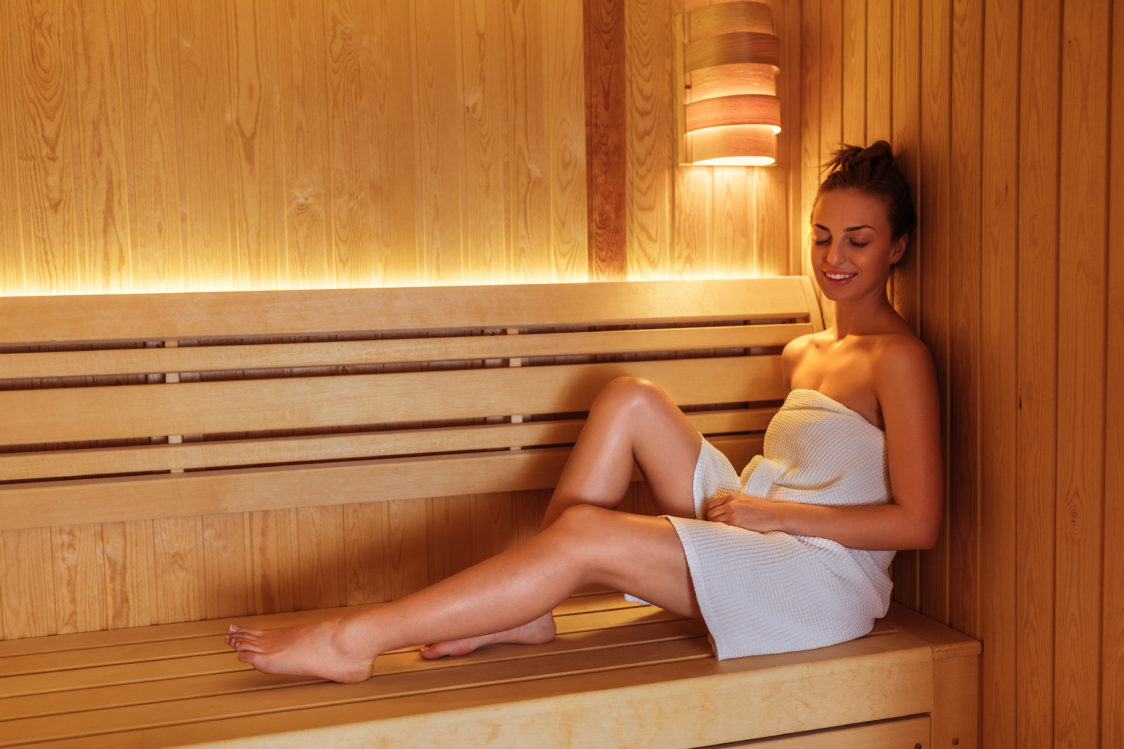
What is the history of sauna?
When you hear the word sauna, most of you will probably think of Finland. And no wonder. There is no state in the world with a richer tradition of this relaxation activity. The word sauna itself even comes from Finnish. The wood-panelled rooms with a fireplace and hot stones, as we know it now, are truly most famous for the people of this country. [3]
But the Finns alone cannot claim all the credit for the invention of saunas. Mentions of hot air baths can be found in the history of the Greeks, Romans, and Arabs. Even in ancient times, people used the power of heated stones, which they poured water on and sat near them. They not only used the stay in a warm environment for relaxation, but also treated a number of diseases. In addition, it was often the most sterile room in the building, making it used as a maternity hospital. In addition, religious and other rituals took place there. Last but not least, it was a place of important social gatherings. [3–4]
Although people don’t give birth in saunas anymore, its social and leisure significance has remained relevant. More and more people visit the sauna to relax, support regeneration and socialize. Thanks to its positive effects and wide popularity, it is part of wellness centres, swimming pools and gyms. Many people also own a home sauna. In Finland, for example, almost every household is equipped with a sauna. [3]

Sauna and its effects on the body
When you are in a sauna, thermoregulatory processes are triggered in your body, which is important for the body’s adaptation to high temperatures. Thanks to that, you can tolerate temperatures around 100 °C. First, your body temperature starts to rise (usually up to 39 °C). Later, the production of sweat increases, which serves as cooling for the body. At the same time, blood vessels dilate, heart rate increases, peripheral parts of the body and blood plasma volume are circulated. On the one hand, it helps to better manage the heat and also serves as a reservoir for fluids for sweating. [5]
At the cellular level, there are changes that occur in the body due to heat and so much more. Heat shock proteins are produced. They protect the cell from being damaged. It also increases the availability of nitric oxide, which promotes blood circulation to the body. When you are in sauna, there are also hormonal changes, which you may also encounter during sports activities. That’s why, for example, the amount of endorphins and growth hormone in the body typically increases. [5–6]
Adaptation of the organism to heat
Regular sauna can then lead to better tolerance of the body to higher temperatures, which you may know as adaptation.[5, 7]
- For example, frequent exposure to heat can lead to a decrease in body temperature during the day. It is then easier for a person with a lower temperature to tolerate a hot environment, which is handy on hot summer days or on exotic holidays.
- For a longer period of time, the amount of blood plasma, which is important for maintaining an athlete’s optimal hydration, can also increase.
- A decrease in heart rate and a faster onset of sweating is also common, which makes it easier to cope with high temperatures as well.
As a result, an athlete is typically able to exercise longer and at a higher intensity. For this reason, many cyclists, runners and other athletes include sauna in their training plans in preparation for races in hot weather. [5, 7]
You might be interested in these products:
Is sauna healthy? 7 reasons why you should go to the sauna
Have you ever wondered if sauna is healthy? Maybe you even tried asking the “most knowledgeable” of them all – Google. Unfortunately, you won’t find a clear answer that applies to everyone. However, a number of studies have confirmed that sauna can be healthy if you follow simple rules. According to experts, this relaxation activity supports, for example, the proper functioning of immunity, heart activity, mental health and sports performance in some aspects. [8]
1. Higher growth hormone levels
The optimal amount of growth hormone in the body is important for the growth and regeneration of muscles and other body tissues. Sports and sauna are the ways to support the production of this substance in the body. A number of studies show that the increased level of growth hormone in the body remains for several hours after you leave the sauna. This can be used not only by athletes striving for maximum muscle growth, but also by people who want to slow down losing the muscle mass, which is associated with getting old. [9]
If you are interested in how to support muscle growth, read our article 10 Nutrition and Training Tips for Maximum Muscle Growth.

2. Improvements in endurance sports
The sauna may not only be beneficial for athletes who want to gain muscle. Runners, cyclists, and other endurance athletes can also benefit from its positive effects. In one study, for example, runners went to a steam sauna for 3 weeks after training. As we know, the results can be comparable, maybe even better in the case of the Finnish sauna. In endurance time trial, the runners performed 1.9% better after they were going to the sauna regularly. [10]
Increased amounts of blood plasma and red blood cells were also observed, which may have increased the availability of oxygen to the muscles. As we know, red blood cells function in the body as a carrier of oxygen, which is key to energy production. Increasing the availability of nitric oxide may also play a role. This typically leads to better blood flow to the muscles and their supply of important nutrients that help with recovery after training. [10]
If you are a fan of endurance sports and are interested in how you can boost your exercise, read our article 11 Best Supplements for Running, Cycling and Other Endurance Sports.
3. Reduction of headaches and back pain
As you already know, staying in a warm environment causes blood vessels to dilate, improves blood circulation and helps your body to relax. All of this can help with headaches, back or joint pain. In addition, in sauna, your body produces more beta-endorphins, which can bind to nerve receptors that suppress pain perception. For many people, pain relief can improve their quality of life. However, if you suffer from ongoing pain, you should consult your doctor to see if the sauna is the right thing for you. [11–12]
At this point, you may think that sauna could also help with delayed onset muscle soreness (DOMS). But don’t get too excited. According to sauna experts, sauna does not have any miraculous effects that would significantly help you reduce muscle pain and thus speed up your return to training. [11, 13]
Thanks to better blood circulation and increased levels of endorphins, your muscles may hurt a little less right after a sauna. Unfortunately, this is usually a temporary effect, which will probably disappear after a few hours. The body responds to a hot environment in the same way as to exercise. That’s why this would be just another burden and not an ideal solution to sore muscles. In this regard, you should rather rely on sufficient rest and massage equipment, such as a massage gun or a foam roller. [11, 13]
Cold water therapy, such as cold baths, can also help with post-workout muscle pain. This is part of The Wim Hof Method, which you will learn more about in the article The Wim Hof Method Promises Stronger Immunity, Better Sleep and More Energy. How to Do It?
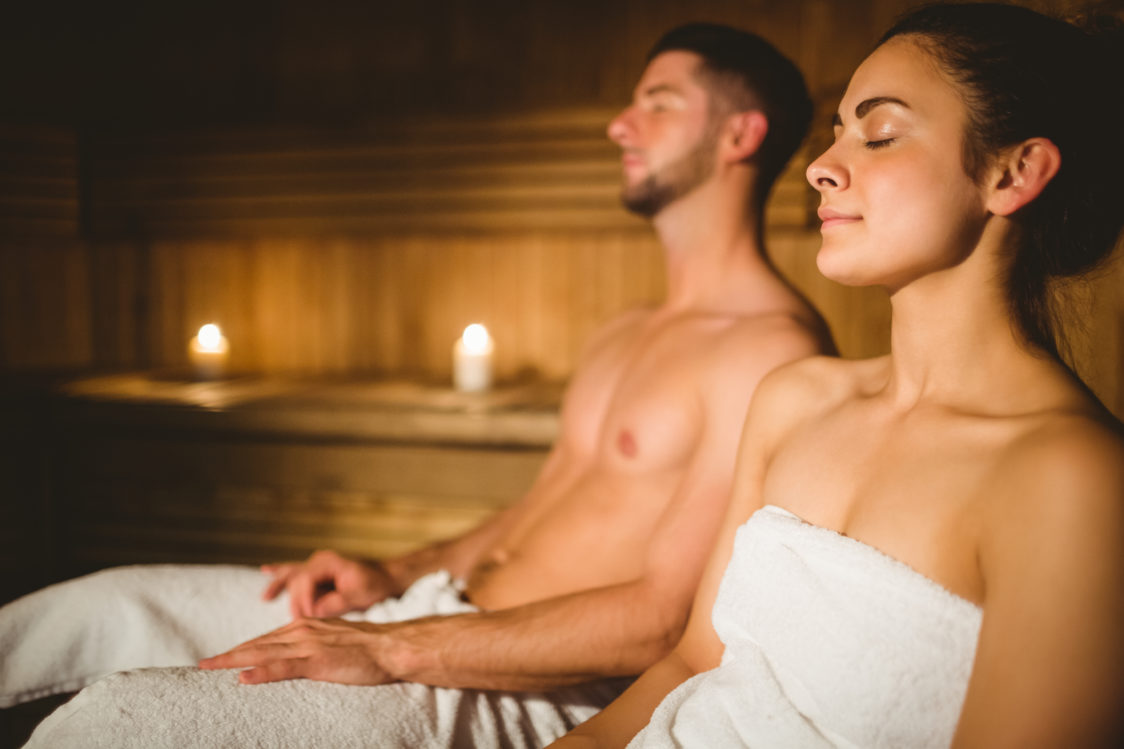
4. Beautiful and healthy skin
In sauna, sweating eliminates impurities, dead cells and improves blood circulation to the skin. You can further support all this by using gentle brushes and skin massage equipment. According to studies, regular visits to the sauna can help hydrate and maintain the natural skin barrier, which protects the skin from external influences. This can help especially people with problematic skin. But never forget a thorough shower and face wash after the last sauna cycle. This will get rid of sweat residues and other impurities that could cause adverse reactions on the skin. If you have sensitive skin, eczema, or other skin conditions, you should consult your dermatologist about visiting the sauna. [14–15]
5. Mental well-being and support of brain functions
In a heated sauna, there is nothing easier than to relax and put your worries aside for later. This is probably the main reason why saunas are so popular. During this process, the body produces a higher production of endorphins – hormones that are associated with feelings of euphoria, happiness and well-being. Studies have also found that sauna can help people with anxiety or depression. [12, 16]
In addition, the researchers concluded that high temperature promotes the production of special proteins in the brain (BDNF – Brain Derived Neurotrophic Factor). These are related to the conservation, growth and proper function of brain cells (neurones). This effect can ultimately lead to better memory, support of thinking and decision-making skills.[12, 16]
If you are looking for more tips on how to reduce stress, tension, and thus get to a better mental state, you should definitely read our article Adaptogens: Natural Substances that Help Manage Stress.

6. Stronger immune system
Stronger immunity is another common reason to visit the sauna, especially in winter. During this period, people are generally more prone to colds and other respiratory diseases. Regular sauna use can then support the production of white blood cells, which are an important part of the body’s defences. The aforementioned heat shock proteins, which protect cells from heat damage, also play a role. They are involved in activating the immune response, which is key to protecting the body from viruses, bacteria, and other unwanted external influences. Thanks to the sauna, you can reduce the risk of flu, colds, and other respiratory diseases. [12]
Another positive effect on health is the reduction in the indicators of inflammation. In short-term studies, the researchers also observed a reduction in oxidative stress, which can manifest itself in cell damage and the development of a number of diseases. In the long run, however, the effect on oxidative stress has not been confirmed by the studies. [17]
For more practical tips on boosting immunity, see our article 15 Ways to Boost Your Immune System and Protect Your Health.
7. Positive effect on heart health and longevity
Speaking of the benefits of sauna, we can not forget the positive effect it has on your heart and blood vessels. According to studies, this resting activity has beneficial effects on some indicators of cardiac function. For example, it can help lower blood pressure in people with hypertension or support vascular function. According to research, it improves their flexibility and also facilitates blood flow. In combination with regular exercise, these effects are even greater. Together, they reduce the likelihood of heart failure, heart attack and other serious diseases. Thus, regular sauna can add some extra lifetime, which is definitely a plus. [12, 18]
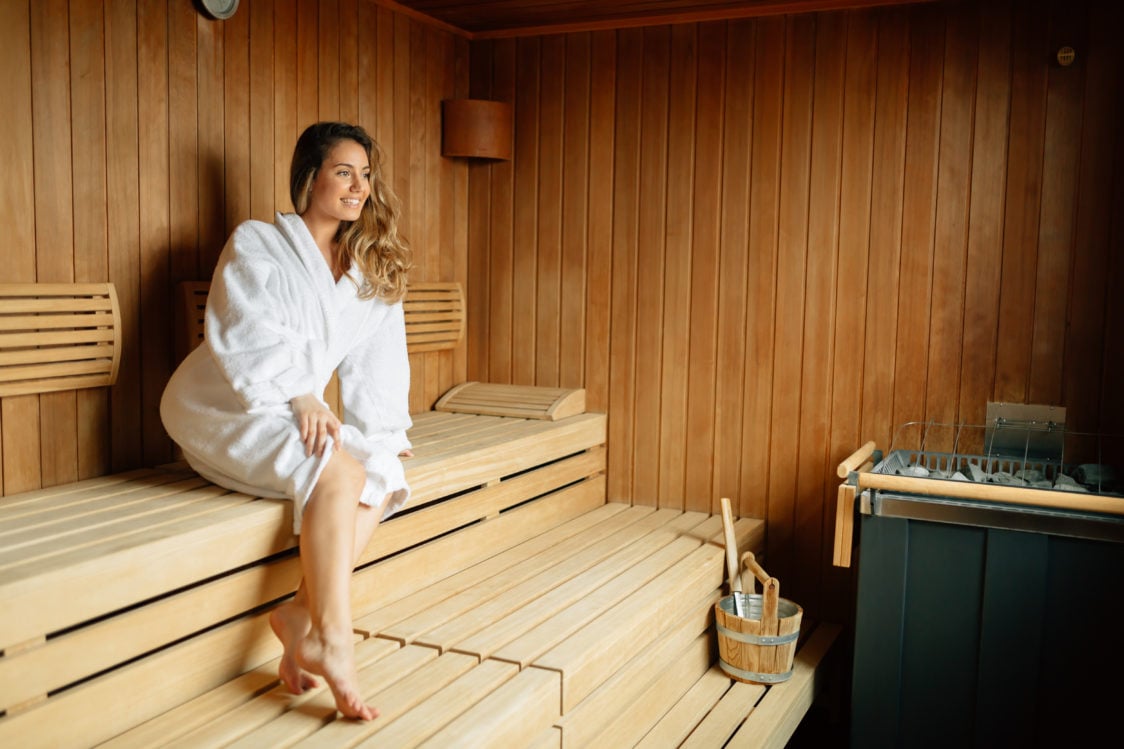
How use sauna the right way?
Now when you know what alternating between heat and cold can bring, it’s time to find out how to behave properly in a sauna. We will unveil all the answers to the most burning questions about sauna below to ensure that you will get the best sauna experience.
1. Is the sauna suitable after exercise?
The sauna (most often an infrared sauna) is now a part of many gyms. After a demanding training, it is very convenient to have a sauna right next door.
- After a light training, feel free to go to the sauna for a few minutes. However, pay even more attention to the continuous replenishment of fluids and electrolytes. The same goes for the Finnish sauna. If you visit it after exercise, make sure you spend there less time than on a regular day when you don’t exercise.
- If you feel very tired after exercise or you have just finished a demanding workout, it is better to leave the sauna for a non-training day. This would be an additional burden for your body instead of relaxation. [21]
2. Is it appropriate to go to the sauna with a cold?
If you have a cold or you’re ill, you should rather skip the sauna. Alternating high heat and cold would probably do you more harm than good. You better rely on rest and go to the sauna when you feel 100% fit again. [22]
If you are also interested in whether it is appropriate to exercise with a cold, read our article Exercise When Being Ill – Yes or No?
3. Can women on their period go to the sauna?
If you tend to have a weaker menstrual period and follow hygienic measures, there is no reason to avoid the sauna. It could even help you with some symptoms such as mild headache, abdominal pain or mental stress. If you are one of the women with heavy menstruation, which is accompanied by nausea and great pain, you should postpone your visit to the sauna for a few days. [23]
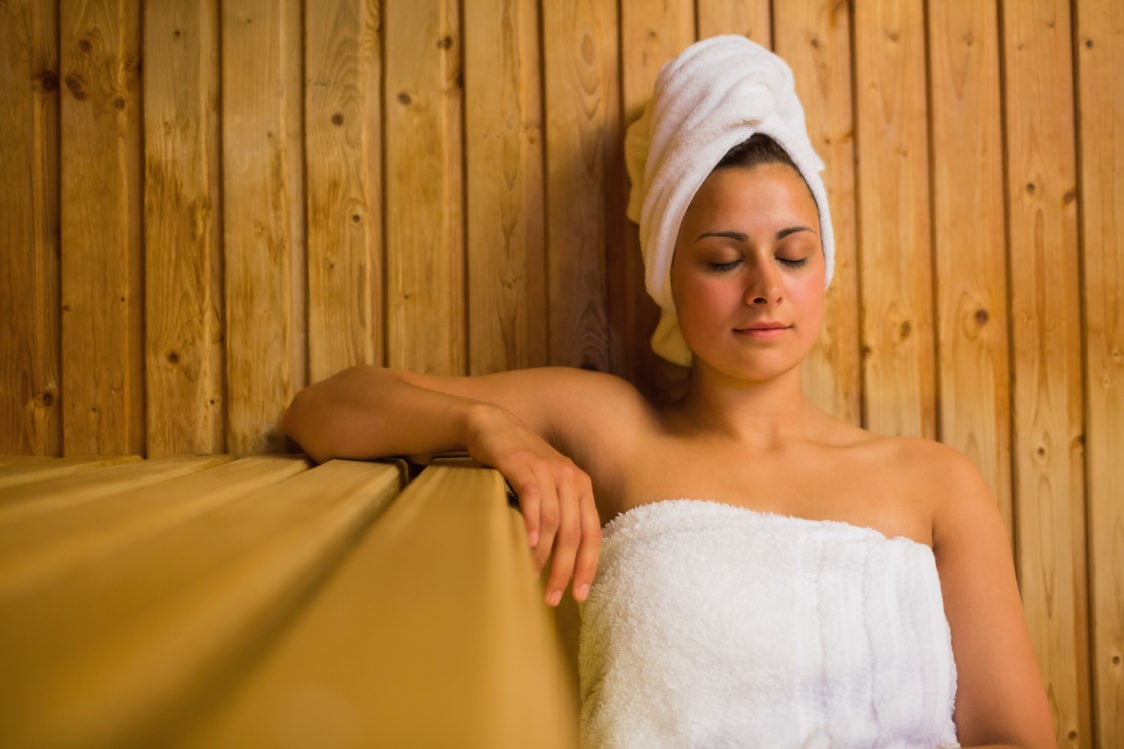
4. How often should you go to a sauna?
If you are just entering the magic of the sauna world, go for it slowly, in all respects. Most experts recommend visiting the sauna 1-3 times a week. From the beginning, go to the sauna once or twice a week. If it suits you, you can add two more sauna days. But keep in mind that it is not appropriate to include sauna on your training day, when you are very tired, sick or you feel weak. [19]
5. How to prepare for sauna?
The rules of sauna etiquette advise that people do not go to it in their clothes or swimsuits. Don’t worry, if you’re ashamed, wrap yourself in the sheet you get at the entrance. Also, don’t forget to take off all your jewellery and watches. Bring a large bottle of water or other soft drink. Then leave it at the entrance to the sauna room. [20]
6. What is a sauna cycle?
One typical sauna cycle consists of three parts:
- Stay in the sauna room (5-15 minutes)
- Cooling phase (30 seconds–5 minutes)
- Rest phase (10-15 minutes)
7. How to behave in a sauna?
For hygienic reasons, you should always have a towel or sheet under you when sitting or lying in the sauna. If you are a sauna beginner, you should sit on the lower bench. There is a slightly lower temperature. Breathe mainly through the nose and rather superficially. You can also use various brushes, rollers, or sauna peeling salt when in the sauna. All this will help you relax your muscles even more, hydrate your skin and remove the remnants of dead skin. [19]

8. How long to stay in a sauna?
It is recommended to stay in the sauna for 5-15 minutes (most people preferring 15-minute intervals). However, if you start to feel dizzy or have other discomforts, you should leave the sauna immediately. [21]
9. How to cool down after the sauna?
After leaving the sauna, head to the shower first. Depending on what is available, you can then take an ice shower, pour over yourself in an ice bucket or cool off in an ice pool or pond. If you are a beginner, do it slowly. Start at the feet and gradually cool the abdomen, back and shoulders. This phase can last only a few seconds, but also 5 minutes. It depends on well-adjusted you are to low temperatures. The last step is the rest. [20]
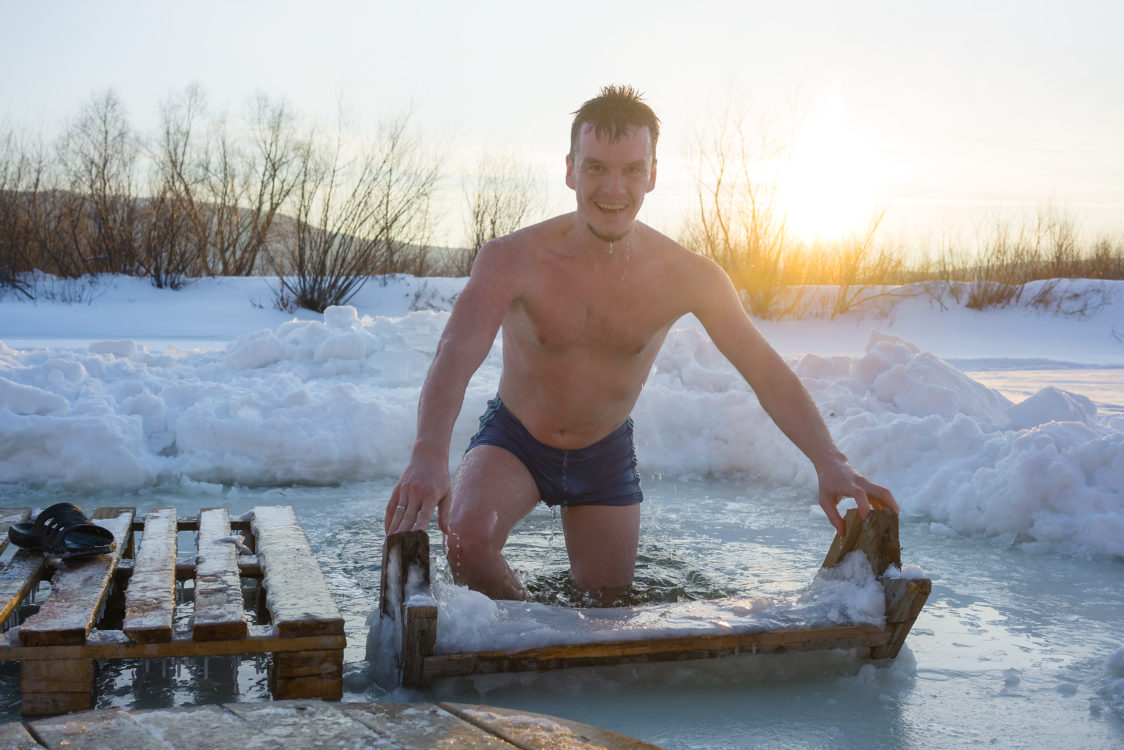
10. What to drink in the sauna?
The rest phase, which normally lasts 10-15 minutes, is ideal for replenishing fluids. Drink only soft drinks. Water, tea or diluted juice are perfect. To spice it up, you can also enjoy a refreshing decaffeinated BCAA drink. In addition to water, electrolytes such as magnesium, sodium, or calcium are lost when sweating. An ionic drink or electrolytes in tablets will help with their replenishment. [19–20]
If you are interested in why fluids replenishment when using sauna and the drinking schedule in general is so important, read the article How Insufficient Drinking Affects Health.
11. How many sauna-cooling-rest cycles should you repeat?
After a rest, you can return to the sauna. This will start the next cycle of the whole process. You can alternate the warm-up, cool-down, and rest phases 2-3 times. Beginners usually go through 2 rounds, whilst advanced people can handle even more than 3. [19]
12. Sauna for beginners and advanced. Is there a difference?
If you are a complete novice in the sauna world, the rules apply to you a little differently than for experienced people. They already know how their body reacts to alternating between heat and cold, so some of them can afford to spend more time in the sauna or cooling pool and also tolerate more cycles.
Sauna for beginners:
- If you have a choice of several types of saunas, feel free to go to the one that heats up to a lower temperature than the Finnish one. Try, for example, an infrared sauna or a bio sauna with temperatures between 45-65 °C.
- In the sauna room, sit on the lower bench and stay there for only 5-10 minutes. Increase the time depending on how well you tolerate the heat.
- Approach the cooling part carefully as well. Start with a cold shower or cooling pool, in which you only need to stay for 10 seconds.
- On the contrary, you can extend the rest phase, easily for 15 minutes. Keep a water bottle with you and replenish fluids at all times.
- Beginners usually only need 2 sauna cycles.

When to visit the sauna and in which cases should you avoid it?
If you are getting some long-term treatment, you should consult your doctor about a visit to the sauna. Sauna can also pose a risk to couples trying to get pregnant. High temperatures can have a negative effect on sperm and male fertility. Sauna is generally not recommended for pregnant women either, as it can lead to some child’s birth defects. [12]
When is sauna suitable? | When is sauna unsuitable (contradiction)? |
|---|---|
| All year long, if you have no contraindications | After a demanding workout, when you are tired or feel weak |
| As a type of rest | After drinking alcohol, when dehydrated |
| After a light workout | In case of acute viral or bacterial infection (flu, cold, indigestion…) |
| On a non-training day | For chronic diseases (heart and vascular diseases, high blood pressure, diabetes) – as per your doctor’s recommendation |
| In preparation for races in warmer climates | When trying to conceive (especially men), during pregnancy |
Summary
Sauna is not just a way to warm up and relax after a busy day. If you follow the basic rules of sauna, you will experience other benefits. The most common benefits include support of immunity, heart and blood vessel function, healthy skin, mental well-being or increased growth hormone levels. It can also help with muscle growth and athletic performance. There are so many reasons to give sauna a chance.
If you liked the article and you learned something new from it, don’t forget to share it with your friends. Maybe you will find some new sauna friends.
[1] Finnish saunas: How they work and their health benefits - Fluidra, perfect pool & wellness experience. – https://www.fluidra.com/projects/finnish-saunas-how-they-work-and-their-health-benefits/
[2] Taiga Times. Finnish sauna culture. – https://taigatimes.com/blog/finnish-sauna-culture/
[3] Saunas.Org. The History of Saunas. – https://saunas.org/the-history-of-saunas/
[4] Oviir, A. (Here’s why the history of the sauna is deeper than you might think. – https://medium.com/estoniansaunas/heres-why-the-history-of-the-sauna-is-deeper-than-you-might-think-d8e5127a8232
[5] Heinonen, I., & Laukkanen, J. A. Effects of heat and cold on health, with special reference to Finnish sauna bathing. – https://doi.org/10.1152/ajpregu.00115.2017
[6] Huhtaniemi, I., & Laukkanen, J. Endocrine effects of sauna bath. – https://doi.org/10.1016/j.coemr.2019.12.004
[7] Moyen, N., M.S., & CSCS. Protecting the Worker-Athelete. – https://kenzen.com/heat-acclimatization-what-is-it-and-why-does-it-matter/
[8] Hannuksela, M. L., & Ellahham, S. Benefits and risks of sauna bathing. – https://doi.org/10.1016/S0002-9343(00)00671-9
[9] ScienceDirect. Sauna use as a lifestyle practice to extend healthspan. – https://www.sciencedirect.com/science/article/pii/S0531556521002916?via%3Dihub#bb0120
[10] PubMed. Effect of post-exercise sauna bathing on the endurance performance of competitive male runners. – https://pubmed.ncbi.nlm.nih.gov/16877041/
[11] Cho, E.-H., Kim, N.-H., Kim, H.-C., Yang, Y.-H., Kim, J., & Hwang, B. Dry sauna therapy is beneficial for patients with low back pain. – https://doi.org/10.17085/apm.2019.14.4.474
[12] Patrick, R. P., & Johnson, T. L. Sauna use as a lifestyle practice to extend healthspan. – https://doi.org/10.1016/j.exger.2021.111509
[13] A Sauna & Muscle Recovery.– https://www.sportsrec.com/5147445/a-sauna-muscle-recovery
[14] Kowatzki, D., Macholdt, C., Krull, K., Schmidt, D., Deufel, T., Elsner, P., & Fluhr, J. W. Effect of regular sauna on epidermal barrier function and stratum corneum water-holding capacity in vivo in humans: A controlled study. – https://doi.org/10.1159/000137283
[15] A Derm Explains. Are Saunas Good for Your Skin? – https://www.dermstore.com/blog/are-saunas-good-for-your-skin/
[16] Max Lugavere. 6 Powerful Ways Saunas Can Boost Your Brain. – https://www.maxlugavere.com/blog/5-incredible-things-that-happen-when-you-sit-in-a-sauna
[17] Kunutsor, S. K., Laukkanen, T., & Laukkanen, J. A. Longitudinal associations of sauna bathing with inflammation and oxidative stress: The KIHD prospective cohort study. – https://doi.org/10.1080/07853890.2018.1489143
[18] Laukkanen, T., Khan, H., Zaccardi, F., & Laukkanen, J. A. Association Between Sauna Bathing and Fatal Cardiovascular and All-Cause Mortality Events. – https://doi.org/10.1001/jamainternmed.2014.8187
[19] Lahti, C. 6 Sauna Tips for Maximum Health Benefits. – https://www.finnleo.com/finnleo-blog/sauna-tips-maximum-health-benefits
[20] SaunaGrow.Com. How to: Use Sauna properly. – https://saunagrow.com/how-to-use-sauna-properly/
[21] Fawkes, JA Guide to Using Sauna to Increase Your Health and Longevity. – https://betterhumans.pub/a-guide-to-using-sauna-to-increase-your-health-and-longevity-4c68d7739132
[22] Sauna: Health benefits, risks, and precautions. – https://www.medicalnewstoday.com/articles/313109
[23] Is Sauna Good for a Woman’s Period & Menstruation? – https://saunahelper.com/is-sauna-good-for-a-womans-period-menstruation/

